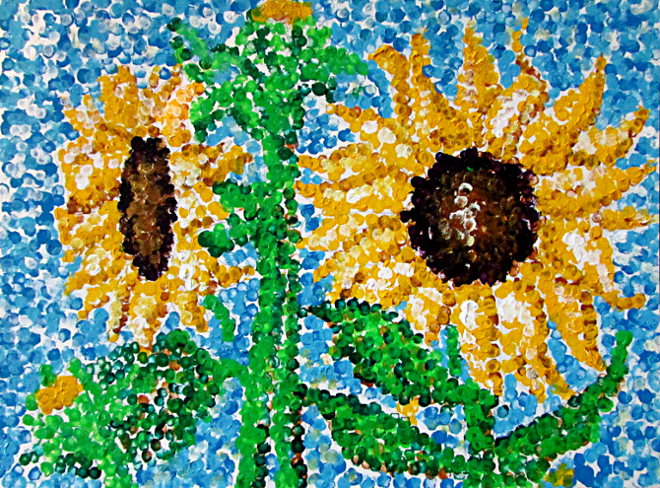We took a poll to find out: "If you could have your very own scrapbooking coach, what would you want her/him to do?" I am going to take one suggestion, each month this year, and find solutions you can use!
January's Question: What is a megapixel and how does it correspond to resolution? I want the photos I take on my cell phone to actually look good!
January's Answer: A megapixel is not a single pixel that's been super sized, lol. Megapixel is shorthand for 1 million pixels. So a five megapixel camera captures 5 million pixels worth of information. A 3 megapixel camera captures 3 million pixels worth. You can expect to pay more for higher resolution, but you get photos that will be very clear even when enlarged. If you're not planning to enlarge the photos to a size larger than 8 by 10 inches, you don't need more than a 5-megapixel camera.
The term resolution comes up everytime I talk about digital scrapbooking, cameras, scanners, and even monitors and printers. Resolution refers to the quality of the image produced by a camera or scanner, displayed by a computer screen, or created by your printer. Resolution measures the number of dots or pixels (which stands for picture elements, the preferred term for dots on the computer screen), per square inch of image a higher resolution means that the image is made up of more, smaller pixels per inch. When you look at a picture on your computer or television screen, you're looking at a bunch of relatively large colored dots. The typical screen resolution for a monitor is 72 dots per inch, abbreviated as DPI. Each dot measures 1/72 of an inch across. Your eye and brain work together to blur the dots into an image. Each dot or pixel has slightly different amounts of the red, green, and blue phosphors that give off of light in those colors. They mix visually to make each dot a different color. If you're familiar with the paintings of George Seurat, the famous pointillist painter, you'll remember that he placed tiny, individual dots of color on his canvas. Because you can actually see the little dots and count them, his paintings are at a very low resolution. He was probably working at about 25 DPI, or 625 (25 squared) little dots of paint per square inch of canvas. With patience like that, he should have been a scrapbooker, lol!

A similar kind of dot is found on the sensor, at the film part of the digital camera. The sensor dots analyze the light that falls on them, determining their percentage of red, green, and blue. Then the digital camera records this information along with the position of the dot in the captured image. That gets to be a lot to remember. So when you upload the picture to the computer from the camera, all that information is included. The more pixels per square inch (PPI) you have to deal with, the higher the resolution of the image, and the more memory it takes to hold it all. So high resolution means bigger files as well as better quality pictures. Of course, it takes more time to open and process a large file. It takes more storage space, both on the camera's flash card and on the computer itself, to save them.
Recording life and those simple moments has become a significant part of our culture and our scrapbooks, thanks to the cameras on our cell phones. Now we know what those camera numbers mean and how to use them to our advantage!
January's Answer: A megapixel is not a single pixel that's been super sized, lol. Megapixel is shorthand for 1 million pixels. So a five megapixel camera captures 5 million pixels worth of information. A 3 megapixel camera captures 3 million pixels worth. You can expect to pay more for higher resolution, but you get photos that will be very clear even when enlarged. If you're not planning to enlarge the photos to a size larger than 8 by 10 inches, you don't need more than a 5-megapixel camera.
The term resolution comes up everytime I talk about digital scrapbooking, cameras, scanners, and even monitors and printers. Resolution refers to the quality of the image produced by a camera or scanner, displayed by a computer screen, or created by your printer. Resolution measures the number of dots or pixels (which stands for picture elements, the preferred term for dots on the computer screen), per square inch of image a higher resolution means that the image is made up of more, smaller pixels per inch. When you look at a picture on your computer or television screen, you're looking at a bunch of relatively large colored dots. The typical screen resolution for a monitor is 72 dots per inch, abbreviated as DPI. Each dot measures 1/72 of an inch across. Your eye and brain work together to blur the dots into an image. Each dot or pixel has slightly different amounts of the red, green, and blue phosphors that give off of light in those colors. They mix visually to make each dot a different color. If you're familiar with the paintings of George Seurat, the famous pointillist painter, you'll remember that he placed tiny, individual dots of color on his canvas. Because you can actually see the little dots and count them, his paintings are at a very low resolution. He was probably working at about 25 DPI, or 625 (25 squared) little dots of paint per square inch of canvas. With patience like that, he should have been a scrapbooker, lol!

A similar kind of dot is found on the sensor, at the film part of the digital camera. The sensor dots analyze the light that falls on them, determining their percentage of red, green, and blue. Then the digital camera records this information along with the position of the dot in the captured image. That gets to be a lot to remember. So when you upload the picture to the computer from the camera, all that information is included. The more pixels per square inch (PPI) you have to deal with, the higher the resolution of the image, and the more memory it takes to hold it all. So high resolution means bigger files as well as better quality pictures. Of course, it takes more time to open and process a large file. It takes more storage space, both on the camera's flash card and on the computer itself, to save them.
Recording life and those simple moments has become a significant part of our culture and our scrapbooks, thanks to the cameras on our cell phones. Now we know what those camera numbers mean and how to use them to our advantage!




























 The "A.B." in ABCreations stands for Anmarie Bowden, that's me! My favorite ice cream is Mississippi Mud from Baskin Robbins, altho I'm partial to Oreos crumbled on top of Vanilla Bean ice cream too! I was born on Super Bowl Sunday. I have been digiscraping since 2000. I live in beautiful sunny California. I am married to my soul mate and we have two gorgeous children. My favorite saying is, “If you think my hands are full, you should see my heart!”
The "A.B." in ABCreations stands for Anmarie Bowden, that's me! My favorite ice cream is Mississippi Mud from Baskin Robbins, altho I'm partial to Oreos crumbled on top of Vanilla Bean ice cream too! I was born on Super Bowl Sunday. I have been digiscraping since 2000. I live in beautiful sunny California. I am married to my soul mate and we have two gorgeous children. My favorite saying is, “If you think my hands are full, you should see my heart!”







































No comments:
Post a Comment